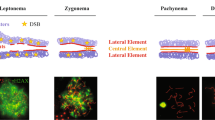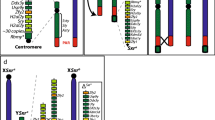Summary
The “X-Y crossover model” described in this paper postulates that (1) the pairing observed between the X and the Y chromosome at zygotene is a consequence of genetic homology, (2) there is a single obligatory crossover between the X and Y pairing segments, and (3) the segment of the X which pairs with the Y is protected from subsequent X inactivation. Genes distal to the proposed crossover (“pseudoautosomal genes”) will appear to be autosomally inherited because they will be transmitted to both male and female offspring. Some criteria for identifying pseudoautosomal genes are outlined.
The existence of a single obligatory crossover between the X and Y of the mouse is strongly supported by a recent demonstration that the sex-reversing mutation Sxr, which is passed equally to XX and XY offspring by male carriers, is transmitted on the sex chromosomes. Pseudoautosomally inherited genes may also be responsible for XX sex reversal in goats and familial XX sex reversal in man.
Similar content being viewed by others
References
Burgoyne PS (1981) The genetics of sex in development. In: Hamilton D, Naftolin F (eds) Basic reproductive medicine, vol 1: Basis and development of reproduction. MIT Press, Cambridge London, pp 1–31
Cattanach BM, Pollard CE, Hawkes SG (1971) Sex-reversed mice: XX and XO males. Cytogenetics 10:318–337
Cox DR, Francke V, Epstein CJ (1981) Assignment of genes to the human X chromosome by the 2-D electrophoretic analysis of total cell proteins from rodent-human somatic cell hybrids. Am J Hum Genet 33:495–512
Darlington CD (1937) Recent advances in cytology. Churchill, London
Densen P, Wilkinson-Kroovand S, Mandell GL, Sullivan G, Øyen R, Marsh WL (1981) Kx: its relationship to chronic granulomatous disease and genetic linkage with Xg. Blood 58:34–37
de la Chapelle A (1972) Analytical review: nature and origin of males with XX sex chromosomes. Am J Hum Genet 24:71–105
de la Chapelle A (1981) The etiology of maleness in XX men. Hum Genet 58:105–116
de la Chapelle A, Schröder J, Murros J, Tallqvist G (1977) Two XX males in one family and additional observations bearing on the etiology of XX males. Clin Genet 11:91–106
de la Chapelle A, Koo GC, Wachtel SS (1978) Recessive sex-determining genes in human XX male syndrome. Cell 15:837–842
Eichwald EJ, Silmser CR (1955) Communication. Transplant Bull 2: 148–149
Evans HJ, Buckton KE, Spowart G, Carothers AD (1979) Heteromorphic X chromosomes in 16,XX males: evidence for the involvement of X-Y interchange. Hum Genet 49:11–31
Ferguson-Smith MA, Sanger R, Tippett P, Aitken DA, Boyd E (1982) A familial X/Y translocation which assigns the Xg blood group locus to the region Xp22.3. Human Gene Mapping 6 (to be published)
Goodfellow PN, Tippett P (1981) A human quantitative polymorphism related to Xg blood groups. Nature 289:404–405
Hamerton JL, Dickson JM, Pollard CE, Grieves SA, Short RV (1969) Genetic intersexuality in goats. J Reprod Fertil [Suppl] 7:25–51
Hultén M (1974) Chiasma distribution at diakinesis in the normal human male. Hereditas 76:55–78
Kasdan R, Nankin HR, Troen P, Wald N, Pan S, Yanaihara T (1973) Paternal transmission of maleness in XX human beings. N Engl J Med 288:539–545
Koller PC, Darlington CD (1934) The genetical and mechanical properties of the sex chromosomes 1 Rattus norvegicus, ♂. J Genet 29:159–173
Lyon MF, Searle AG, Ford CE, Ohno S (1964) A mouse translocation suppressing sex-linked variegation. Cytogenetics 3:306–323
Lyon MF, Cattanach BM, Charlton HM (1981) Genes affecting sex differentiation in mammals. In: Austin CR, Edwards RG (eds) Mechanisms of sex differentiation in animals and man. academic Press, New York San Francisco London, pp 329–386
Merril CR, Goldman D, Sedman SA, Ebert MH (1981) Ultrasensitive stain for proteins in polyacrylamide gels shows regional variation in cerebrospinal fluid proteins. Science 211:1437–1438
Mohandas T, Shapiro LJ, Sparkes RS, Sparkes MC (1979) Regional assignment of the steroid sulfatase-X-linked ichthyosis locus: implications for a noninactivated region on the short arm of human X-chromosome. Proc Natl Acad Sci USA 76:5779–5783
Moses MJ, Counce SJ, Paulson DF (1975) Synaptonemal complex complement of man in spreads of spermatocytes, with details of the sex chromosome pair. Science 187:363–365
O'Farrell PH (1975) High resolution two-dimensional electrophoresis of proteins. J Biol Chem 250:4007–4021
Ohno S (1969) Evolution of sex chromosomes in mammals. Annu Rev Genet 3:495–524
Ohno S (1976) Major regulatory genes for mammalian sexual development. Cell 7:315–321
Ohno S, Kaplan W, Kinosita R (1959) Do XY- and O-sperm occur in Mus musculus? Exp Cell Res 18:382–384
Pearson PL, Bobrow M (1970) Definitive evidence for the short arm of the Y chromosome associating with the X during meiosis in the human male. Nature 226:959–961
Polani PE (1982) Pairing of X and Y chromosomes, non-inactivation of X-linked genes, and the maleness factor. Hum Genet (to be published)
Race RR, Sanger R (1975) Blood groups in man, 6th edn. Blackwell Scientific Publ, Oxford London Edinburgh Melbourne
Rasmussen SW, Holm PB (1980) Mechanics of meiosis. Hereditas 93: 187–216
Ruddle FH (1981) A new era in gene mapping: somatic cell genetics and recombinant DNA methodologies. Nature 294:115–120
Shapiro LJ, Mohandas T, Weiss R, Romeo G (1979) Non-inactivation of an X-chromosome locus in man. Science 204:1224–1226
Shows TB (1979) The X chromosome gene map. In: Vallet HL, Porter IH (eds) Genetic mechanisms of sexual development. Academic Press, New York San Francisco London, pp 253–269
Silvers WK, Gasser DL, Eicher EM (1982) The H-Y antigen, serologically detectable male antigen, and sex determination. Cell 28:439–440
Simpson E, McLaren A, Chandler (1982) Evidence for two male antigens in mice. Immunogenetics (to be published)
Singh L, Jones KW (1982) Sex reversal in the mouse (Mus musculus) is caused by a recurrent nonreciprocal crossover involving the X and an aberrant Y chromosome. Cell 28:205–216
Solari AJ (1974) The behaviour of the XY pair in mammals. Int Rev Cytol 38:273–317
Solari AJ (1980) Synaptonemal complexes and associated structures in microspread human spermatocytes. Chromosoma 81:315–337
Soller M, Padeh B, Wysoki M, Ayalon N (1969) Cytogenetics of Saanen goats showing abnormal development of the reproductive tract associated with the dominant gene for polledness. Cytogenetics 8: 51–62
Tiepolo L, Zuffardi O, Fraccaro M, di Natale D, Gargantini L, Müller CR, Ropers HH (1980) Assignment by deletion mapping of the steroid sulfatase-X-linked ichthyosis locus to Xp 223. Hum Genet 54:205–206
Wachtel SS, Ohno S, Koo GC, Boyse EA (1975) Possible role for H-Y antigen in the primary determination of sex. Nature 257:235–236
Wachtel SS, Basrur P, Koo GC (1978) Recessive male-determining genes. Cell 15:279–281
Wiberg U, Mayerová A, Muller U, Fredga K, Wolf U (1982) X-linked genes of the H-Y antigen system in the wood lemming (Myopus schistocolor). Hum Genet 60:163–166
Winsor EJT, Ferguson-Smith MA, Shire JGM (1978) Meiotic studies in mice carrying the sex reversal (Sxr) factor. Cytogenet Cell Genet 21:11–18
Wolf U (1981) The H-Y antigen system: interaction of several genes in gonadal differentiation. In: Byskov AG, Peters H (eds) Development and function of reproductive organs. Excerpta Medica, Amsterdam Oxford Princeton, pp 260–263
Wolf U, Fraccaro M, Mayerová A, Hecht T, Maraschio P, Hameister H (1980) A gene controlling H-Y antigen on the X chromosome. Tentative assignment by deletion mapping to Xp223. Hum Genet 54:315–318
References
Cattanach BM, Evans EP, Burtenshaw MD, Barlow J (submitted to Nature) Male and female development in mice of identical chromosome constitution
Evans EP, Burtenshaw MD, Cattanach BM (submitted to Nature) Cytological evidence for meiotic crossing over between the X and Y chromosomes in male mice carrying the sex reversing (Sxr) factor
McLaren A, Monk M (submitted to Nature) Sex reversed can be subject to X inactivation in the mouse
Author information
Authors and Affiliations
Rights and permissions
About this article
Cite this article
Burgoyne, P.S. Genetic homology and crossing over in the X and Y chromosomes of mammals. Hum Genet 61, 85–90 (1982). https://doi.org/10.1007/BF00274192
Received:
Issue Date:
DOI: https://doi.org/10.1007/BF00274192




